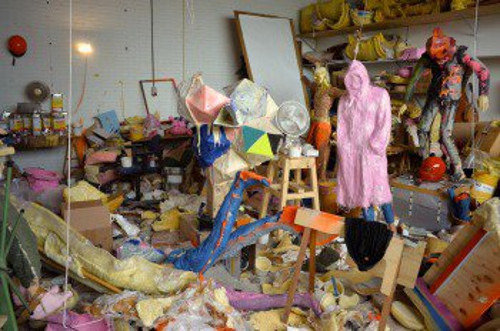Folkert de Jong
dal 26/11/2015 al 15/1/2016
Segnalato da
26/11/2015
Folkert de Jong
Galerie Fons Welters, Amsterdam
The exhibition focuses on elements of justice: from the design of courtrooms to the manipulation of juries, the theatricality surrounding a judgement, and the following isolation.

Galerie Fons Welters is proud to invite you to Folkert de Jong's second solo exhibition, Court of Justice, opening during Amsterdam Art Weekend 2015. De Jong's expressive sculptures arise from a strong fascination with the psychological and bodily human condition. As the title of the exhibition already indicates, the artist now focuses specifically on elements of justice—from the hierarchical design of courtrooms to the psychological manipulation of juries, the theatricality surrounding a judgement, and the following isolation.
But who is summoned to court? And who is to judge? Folkert de Jong's Court of Justice is a peculiar fusion of courtroom and prison; a space in between, primarily resembling a scientific laboratory.
De Jong is known for his idiosyncratic use of insulation materials such as polyurethane and styrofoam. Recently, however, he has broadened his material palette—for instance, with transparent Plexiglas vitrines, enclosing foam assemblages of body parts and objects, as if preserved in formaldehyde. Although the psychedelic, brightly coloured plastic seems to radiate light; it also hermetically seals off its contents and filters reality. Within these see-through walls, a transcendental experience might take place. While De Jong's "reservoirs" emphasise this theatrical effect of museum displays and refer to art historical uses of the vitrine—by the Surrealists, for instance—they also visualise a contemporary urge to conservation and immortality.
De Jong even takes it one step further. The central piece in the gallery space is a large Perspex isolation cell, wherein readymade objects have been placed, clearly hinting at Marcel Duchamp. A toilet of stainless steel from a prison cell and a bright orange surgical stretcher chair create a strange (and estranging) setting together. While the surrounding acrylic glass generates distance, time markers and cries, carved from the inside, reveal someone's previous confinement. Here the eccentric, grotesque character of De Jong's earlier work has been replaced by a clinical feeling of oppression. How long did time stand still in here? Via a long tube, the cell connects with an adjacent chemical test display, where energy seems to bubble. As in a time machine, there is an alluring, hopeful opening for escape—a potential teleportation.
Next to the constellation of different Perspex vitrines, De Jong shows three long metal tables, each with six stools directly attached to them. Designed in such a way that there is not a single loose element encouraging violent use, these reproductions of prison dining tables also contain the anonymity of penitentiaries. The identical stools remain unoccupied; the table tops surprisingly function as plinths for three crystal sculptures, self-consciously displaying themselves. Colourful bismuth, for instance, that spirals down in endless, rectangular passages. What do these gemstones, sparkling yet sharp, embody? Their healing powers are in flat contradiction to the toxic and non-decomposable synthetic materials from which the artist has made them.
While De Jong has represented immoral human behaviour in previous works, he now questions the morality of things themselves. Can an object be intrinsically good or bad? Could an item be put on trial?
Except for a hologram self-portrait of the artist created from MRI data, the human figure has disappeared for the first time in De Jong's Court of Justice. Now, more than ever, it is up to the visitor to judge.
Biography:
Folkert de Jong was born in 1972 in Egmond aan Zee, The Netherlands, and studied at the Academy for Visual Arts and the Rijksakademie for Visual Arts in Amsterdam. In 2003, he was awarded the Prix de Rome for Sculpture. Recent solo exhibitions include: Actus Tragicus, Luis Adelantado, Mexico City (Mexico); The Holy Land, James Cohan Gallery, NY (US) (2015); Hominid Lands, Musee d'Evreux (France); The Holy Land, Hepworth Wakefield (UK) (2014); Amabilis insania. The pleasing delusion, Middelheim Museum, Antwerp (Belgium); Un Vie d'Illusions, Musée d'art Contemporain, Rocheouart (France); Actus Tragicus, MUDAM Museum, Luxembourg; Portland Art Museum, Portland, Oregon (US) (2013); The Immortals, Mackintosh Museum Glasgow (Scotland) (2012); Vitrine de la Maison du Peuple, Clichy (France) (2011); Mount Maslow, Hudson Valley Center for Contemporary Art, Peekskill, New York (US); The Shooting, Wadsworth Atheneum, Hartford, Connecticut (US); Circle of Trust: Selected Works 2001–2009, Groninger Museum, Groningen (Netherlands) (2009).
Futhermore, his work has recently been featured in: Picasso in Contemporary Art, Deichtorhallen, Hamburg (Germany) (2015); De Anatomische Les, Gemeentemuseum, The Hague (Netherlands); The Best of Times, The Worst of Times: The First Kiev International Biennale of Contemporary Art (Ukraine) (2013); The Glasgow International Festival of Visual Art, Scotland; Fantastic 2012, Lille 3000, Le Tripostal, Lille (France); Beaufort 04, Blankenberge (Belgium) (2012); The shape of things to come: new sculpture, Saatchi Gallery London (UK) (2011); and the 17th Biennale of Sydney: The Beauty of Distance: Songs of Survival in a Precarious Age (Australia) (2010).
Image: Folkert de Jong Seht der Mensch (The Shooting Lesson), 2007 Styrofoam, Polyurethane foam, pigment Approx. 800 x 800 x 400 cm
Opening: Friday, November 27, 5–8pm (as part of Amsterdam Art Weekend)
Galerie Fons Welters
Bloemstraat 140 1016 LJ Amsterdam
Hours: Tuesday - Saturday, 13 - 18
Admission: free



